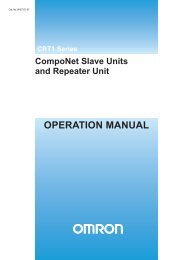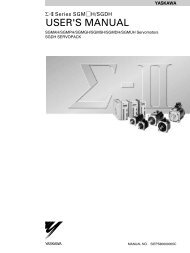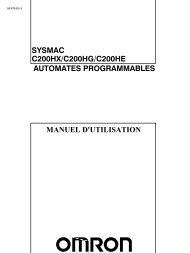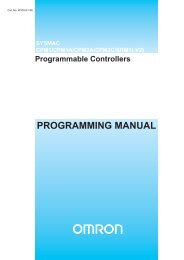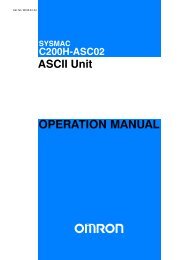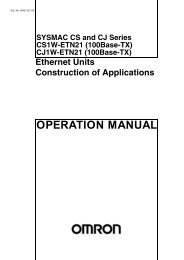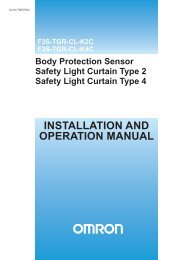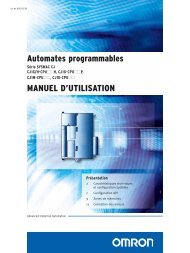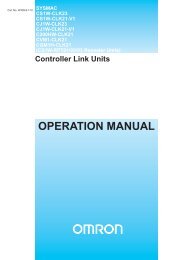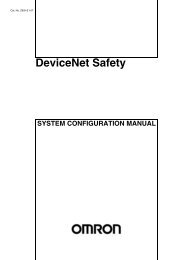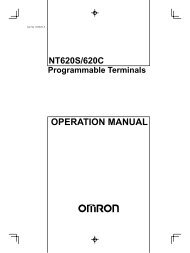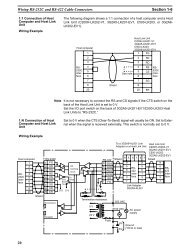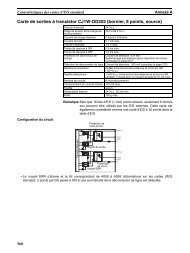- Page 1 and 2: Cat. No. Z901-E1-05 SYSMAC NE1S Ser
- Page 4 and 5: Notice: OMRON products are manufact
- Page 6 and 7: Serial Gateway (Converting from FIN
- Page 8 and 9: TABLE OF CONTENTS PRECAUTIONS . . .
- Page 10 and 11: TABLE OF CONTENTS SECTION 10 Outlin
- Page 12 and 13: Appendices TABLE OF CONTENTS A Vari
- Page 14 and 15: About this Manual: This manual desc
- Page 16 and 17: Read and Understand this Manual Ple
- Page 18: Disclaimers CHANGE IN SPECIFICATION
- Page 21 and 22: Intended Audience 1 1 Intended Audi
- Page 23 and 24: Operating Environment Precautions 4
- Page 25 and 26: Application Precautions 5 xxvi Leav
- Page 27 and 28: Conformance to EC Directives 6 6-3
- Page 29 and 30: Conformance to EC Directives 6 xxx
- Page 31: NE1S Series Features Section 1-1 1-
- Page 35 and 36: NE1S Series Features Section 1-1 In
- Page 37 and 38: NE1S Series Features Section 1-1 De
- Page 39 and 40: Specifications Section 1-2 Performa
- Page 41 and 42: Specifications Section 1-2 Item Spe
- Page 43 and 44: Specifications Section 1-2 Internal
- Page 45 and 46: Specifications Section 1-2 Program
- Page 47 and 48: System Configuration Section 1-3 1-
- Page 49 and 50: System Configuration Section 1-3 Na
- Page 51 and 52: System Configuration Section 1-3 Mi
- Page 53 and 54: System Configuration Section 1-3 24
- Page 55 and 56: System Configuration Section 1-3 26
- Page 57 and 58: System Configuration Section 1-3 1-
- Page 59 and 60: Main Differences and Restrictions C
- Page 61 and 62: Main Differences and Restrictions C
- Page 63 and 64: Main Differences and Restrictions C
- Page 65 and 66: NE1S-series Structure Section 2-1 2
- Page 67 and 68: NE1S-series Structure Section 2-1 E
- Page 69 and 70: NE1S-series Structure Section 2-1 4
- Page 71 and 72: Variables Section 2-2 Creating Prog
- Page 73 and 74: Variables Section 2-2 2-2-3 Variabl
- Page 75 and 76: Variables Section 2-2 46 Data type
- Page 77 and 78: Variables Section 2-2 Setting the P
- Page 79 and 80: Variables Section 2-2 50 Local Vari
- Page 81 and 82: Variables Section 2-2 52 ues cannot
- Page 83 and 84:
Variables Section 2-2 54 Physical a
- Page 85 and 86:
Function Blocks Section 2-3 56 ■
- Page 87 and 88:
Function Blocks Section 2-3 58 Func
- Page 89 and 90:
Function Blocks Section 2-3 60 !Cau
- Page 91 and 92:
Function Blocks Section 2-3 2-3-3 F
- Page 93 and 94:
Function Blocks Section 2-3 64 The
- Page 95 and 96:
Function Blocks Section 2-3 Operati
- Page 97 and 98:
Function Blocks Section 2-3 Placeme
- Page 99 and 100:
Function Blocks Section 2-3 Connect
- Page 101 and 102:
Function Blocks Section 2-3 Restric
- Page 103 and 104:
Function Blocks Section 2-3 ST Prog
- Page 105 and 106:
Programming Notes Section 2-4 2-4-3
- Page 107 and 108:
Programming Notes Section 2-4 78
- Page 109 and 110:
CPU Unit Section 3-1 3-1 CPU Unit 3
- Page 111 and 112:
CPU Unit Section 3-1 Indicator Colo
- Page 113 and 114:
CPU Unit Section 3-1 3-1-3 Internal
- Page 115 and 116:
CPU Unit Section 3-1 86 (2) DM Area
- Page 117 and 118:
CPU Unit Section 3-1 File Operation
- Page 119 and 120:
CPU Unit Section 3-1 Unit Classific
- Page 121 and 122:
CPU Unit Section 3-1 92 Note Minimu
- Page 123 and 124:
Power Supply Units Section 3-2 24-V
- Page 125 and 126:
Backplanes Section 3-3 Components a
- Page 127 and 128:
Backplanes Section 3-3 Components a
- Page 129 and 130:
Basic I/O Units Section 3-4 Dimensi
- Page 131 and 132:
Basic I/O Units Section 3-4 102 Mod
- Page 133 and 134:
Basic I/O Units Section 3-4 104 Inp
- Page 135 and 136:
Basic I/O Units Section 3-4 Dimensi
- Page 137 and 138:
Basic I/O Units Section 3-4 108
- Page 139 and 140:
General Tab Page Section 4-1 4-1 Ge
- Page 141 and 142:
General Tab Page Section 4-1 Cycle
- Page 143 and 144:
General Tab Page Section 4-1 USB Po
- Page 145 and 146:
Ethernet Settings Section 4-2 4-1-7
- Page 147 and 148:
Ethernet Settings Section 4-2 4-2-3
- Page 149 and 150:
Ethernet Settings Section 4-2 4-2-4
- Page 151 and 152:
Ethernet Settings Section 4-2 4-2-7
- Page 153 and 154:
Ethernet Settings Section 4-2 Email
- Page 155 and 156:
Ethernet Settings Section 4-2 SEND
- Page 157 and 158:
Ethernet Settings Section 4-2 4-2-9
- Page 159 and 160:
Ethernet Settings Section 4-2 4-2-1
- Page 161 and 162:
Build Settings Section 4-3 132
- Page 163 and 164:
Introduction Section 5-1 5-1 Introd
- Page 165 and 166:
I/O Memory Areas Section 5-2 5-2-2
- Page 167 and 168:
I/O Memory Areas Section 5-2 Auxili
- Page 169 and 170:
I/O Memory Areas Section 5-2 5-2-3
- Page 171 and 172:
CIO Area Section 5-3 Normal I/O Ref
- Page 173 and 174:
CIO Area Section 5-3 Limitations on
- Page 175 and 176:
CIO Area Section 5-3 IORF(097) Refr
- Page 177 and 178:
CPU Bus Unit Area Section 5-5 Forci
- Page 179 and 180:
Special I/O Unit Area Section 5-6 5
- Page 181 and 182:
Holding Area Section 5-8 Holding Ar
- Page 183 and 184:
Auxiliary Area Section 5-9 5-9-1 Re
- Page 185 and 186:
Auxiliary Area Section 5-9 Address
- Page 187 and 188:
Auxiliary Area Section 5-9 Address
- Page 189 and 190:
Auxiliary Area Section 5-9 Address
- Page 191 and 192:
Auxiliary Area Section 5-9 Address
- Page 193 and 194:
Auxiliary Area Section 5-9 Address
- Page 195 and 196:
Auxiliary Area Section 5-9 Address
- Page 197 and 198:
Auxiliary Area Section 5-9 Address
- Page 199 and 200:
Auxiliary Area Section 5-9 Address
- Page 201 and 202:
Auxiliary Area Section 5-9 Address
- Page 203 and 204:
Auxiliary Area Section 5-9 Address
- Page 205 and 206:
Auxiliary Area Section 5-9 5-9-2 Re
- Page 207 and 208:
Auxiliary Area Section 5-9 Addresse
- Page 209 and 210:
TR (Temporary Relay) Area Section 5
- Page 211 and 212:
Counter Area Section 5-12 182 4. Th
- Page 213 and 214:
Extended Data Memory (EM) Area Sect
- Page 215 and 216:
Index Registers Section 5-15 Exampl
- Page 217 and 218:
Index Registers Section 5-15 188 If
- Page 219 and 220:
Data Registers Section 5-16 5-16 Da
- Page 221 and 222:
Task Flags Section 5-17 Precautions
- Page 223 and 224:
Clock Pulses Section 5-19 5-19 Cloc
- Page 225 and 226:
Parameter Areas Section 5-20 5-20-4
- Page 227 and 228:
Introduction Section 6-1 6-1 Introd
- Page 229 and 230:
Examples Section 6-2 6-2 Examples 1
- Page 231 and 232:
Examples Section 6-2 202 3. Check t
- Page 233 and 234:
Examples Section 6-2 7. DM Area Ini
- Page 235 and 236:
Examples Section 6-2 206 Output OFF
- Page 237 and 238:
Examples Section 6-2 208
- Page 239 and 240:
Fail-safe Circuits Section 7-1 7-1
- Page 241 and 242:
Installation Section 7-2 7-2 Instal
- Page 243 and 244:
Installation Section 7-2 7-2-2 Inst
- Page 245 and 246:
Installation Section 7-2 Routing Wi
- Page 247 and 248:
Installation Section 7-2 7-2-5 Moun
- Page 249 and 250:
Installation Section 7-2 DIN Track
- Page 251 and 252:
Installation Section 7-2 222 Total
- Page 253 and 254:
Wiring Section 7-3 224 C200HW-PA204
- Page 255 and 256:
Wiring Section 7-3 RUN Output (C200
- Page 257 and 258:
Wiring Section 7-3 Wiring Communica
- Page 259 and 260:
Wiring Section 7-3 Wiring Do not re
- Page 261 and 262:
Wiring Section 7-3 Wiring Procedure
- Page 263 and 264:
Wiring Section 7-3 Preassembled Cab
- Page 265 and 266:
Wiring Section 7-3 7-3-4 Connecting
- Page 267 and 268:
Wiring Section 7-3 AC Input Units T
- Page 269 and 270:
Wiring Section 7-3 Output Leakage C
- Page 271 and 272:
Network Installation Section 7-4 7-
- Page 273 and 274:
Network Installation Section 7-4 St
- Page 275 and 276:
Connecting to the Network Section 7
- Page 277 and 278:
Installation Preparations Section 8
- Page 279 and 280:
Installing the NE Programmer and Ne
- Page 281 and 282:
Installing the USB Driver Section 8
- Page 283 and 284:
Installing the USB Driver Section 8
- Page 285 and 286:
What is the Network Configurator? S
- Page 287 and 288:
Network Connections Section 9-4 9-4
- Page 289 and 290:
Starting NE Programmer Section 9-5
- Page 291 and 292:
Starting NE Programmer Section 9-5
- Page 293 and 294:
Starting the NE Programmer Section
- Page 295 and 296:
Project Window Section 10-3 Propert
- Page 297 and 298:
Menu Item Lists Section 10-4 Bookma
- Page 299 and 300:
Menu Item Lists Section 10-4 Invert
- Page 301 and 302:
Menu Item Lists Section 10-4 Set -
- Page 303 and 304:
Shortcut Keys Section 10-5 10-5-3 E
- Page 305 and 306:
Option Settings Section 10-6 10-6-1
- Page 307 and 308:
Option Settings Section 10-6 10-6-3
- Page 309 and 310:
Option Settings Section 10-6 Edit T
- Page 311 and 312:
Option Settings Section 10-6 10-6-6
- Page 313 and 314:
Option Settings Section 10-6 10-6-8
- Page 315 and 316:
286 11-9 Using the Library. . . . .
- Page 317 and 318:
Creating Projects and Logical POUs
- Page 319 and 320:
Programming Methods Section 11-3 11
- Page 321 and 322:
Programming Methods Section 11-3 In
- Page 323 and 324:
Programming Methods Section 11-3 29
- Page 325 and 326:
Programming Methods Section 11-3 Re
- Page 327 and 328:
Programming Methods Section 11-3 29
- Page 329 and 330:
Programming Methods Section 11-3 In
- Page 331 and 332:
Programming Methods Section 11-3 30
- Page 333 and 334:
Programming Methods Section 11-3 11
- Page 335 and 336:
Programming Methods Section 11-3 Re
- Page 337 and 338:
Creating Function Blocks and Pastin
- Page 339 and 340:
Creating Function Blocks and Pastin
- Page 341 and 342:
Creating Function Blocks and Pastin
- Page 343 and 344:
Creating Function Blocks and Pastin
- Page 345 and 346:
Creating Configurations and Assigni
- Page 347 and 348:
Creating Configurations and Assigni
- Page 349 and 350:
Editing Comments Section 11-6 11-6
- Page 351 and 352:
Search/Replace Function Section 11-
- Page 353 and 354:
Search/Replace Function Section 11-
- Page 355 and 356:
Cross Reference Function Section 11
- Page 357 and 358:
Using the Library Section 11-9 328
- Page 359 and 360:
Using the Library Section 11-9 11-9
- Page 361 and 362:
Using the Library Section 11-9 Rung
- Page 363 and 364:
Building and Compiling Programs Sec
- Page 365 and 366:
Importing and Exporting Section 11-
- Page 367 and 368:
Printing Section 11-13 338 2. Speci
- Page 369 and 370:
Printing Section 11-13 340
- Page 371 and 372:
Overview Section 12-1 12-1 Overview
- Page 373 and 374:
Build Settings (Build Tab Page) Sec
- Page 375 and 376:
I/O Table Settings (I/O Table Tab P
- Page 377 and 378:
I/O Table Settings (I/O Table Tab P
- Page 379 and 380:
350 13-12 Changing Timer/Counter Se
- Page 381 and 382:
Connecting via Serial Communication
- Page 383 and 384:
Connecting Online via Ethernet Sect
- Page 385 and 386:
Connecting Online via Ethernet Sect
- Page 387 and 388:
Automatic Upload Function Section 1
- Page 389 and 390:
Automatic Upload Function Section 1
- Page 391 and 392:
Changing the CPU Unit That Is Conne
- Page 393 and 394:
Online Operations for I/O Tables Se
- Page 395 and 396:
Uploading, Downloading, and Compari
- Page 397 and 398:
Uploading, Downloading, and Compari
- Page 399 and 400:
Uploading, Downloading, and Compari
- Page 401 and 402:
Monitoring Section 13-8 13-8-2 Star
- Page 403 and 404:
Monitoring Section 13-8 Monitoring
- Page 405 and 406:
Saving and Restoring Variable PVs S
- Page 407 and 408:
Forcing Bits ON and OFF (Force-set
- Page 409 and 410:
Differential Monitor Section 13-13
- Page 411 and 412:
Online Editing Section 13-14 13-14-
- Page 413 and 414:
Clearing Errors Section 13-15 13-14
- Page 415 and 416:
Displaying Errors and the Error Log
- Page 417 and 418:
Displaying Errors and the Error Log
- Page 419 and 420:
Change Log Section 13-19 13-19 Chan
- Page 421 and 422:
Displaying the Cycle Time Section 1
- Page 423 and 424:
Data Tracing Section 13-21 394 2. M
- Page 425 and 426:
Data Tracing Section 13-21 13-21-4
- Page 427 and 428:
Variable Reference List Section 13-
- Page 429 and 430:
Setting the CPU Unit Clock Section
- Page 431 and 432:
File Memory Section 14-1 14-1 File
- Page 433 and 434:
File Memory Section 14-1 14-1-2 Fil
- Page 435 and 436:
File Memory Section 14-1 Backup Fil
- Page 437 and 438:
File Memory Section 14-1 System Fil
- Page 439 and 440:
File Memory Section 14-1 f) Carriag
- Page 441 and 442:
File Memory Section 14-1 412 Exampl
- Page 443 and 444:
Manipulating Files Section 14-2 414
- Page 445 and 446:
Manipulating Files Section 14-2 Bac
- Page 447 and 448:
Manipulating Files Section 14-2 Uni
- Page 449 and 450:
Manipulating Files Section 14-2 Com
- Page 451 and 452:
Manipulating Files Section 14-2 422
- Page 453 and 454:
Manipulating Files Section 14-2 Rel
- Page 455 and 456:
Formatting the Memory Card Section
- Page 457 and 458:
CPU Unit Operation Section 15-1 15-
- Page 459 and 460:
CPU Unit Operating Modes Section 15
- Page 461 and 462:
CPU Unit Operating Modes Section 15
- Page 463 and 464:
Power OFF Operation Section 15-3 Po
- Page 465 and 466:
Instruction Execution Times and Num
- Page 467 and 468:
Instruction Execution Times and Num
- Page 469 and 470:
Instruction Execution Times and Num
- Page 471 and 472:
Instruction Execution Times and Num
- Page 473 and 474:
Instruction Execution Times and Num
- Page 475 and 476:
Instruction Execution Times and Num
- Page 477 and 478:
Instruction Execution Times and Num
- Page 479 and 480:
Instruction Execution Times and Num
- Page 481 and 482:
Instruction Execution Times and Num
- Page 483 and 484:
Error Log Section 16-1 16-1 Error L
- Page 485 and 486:
Error Processing Section 16-2 Indic
- Page 487 and 488:
Error Processing Section 16-2 16-2-
- Page 489 and 490:
Error Processing Section 16-2 CPU S
- Page 491 and 492:
Error Processing Section 16-2 Unit/
- Page 493 and 494:
Error Processing Section 16-2 Non-f
- Page 495 and 496:
Error Processing Section 16-2 Commu
- Page 497 and 498:
Error Processing Section 16-2 16-2-
- Page 499 and 500:
Error Processing Section 16-2 16-2-
- Page 501 and 502:
Troubleshooting Racks and Units Sec
- Page 503 and 504:
Troubleshooting Racks and Units Sec
- Page 505 and 506:
Inspections Section 17-1 17-1 Inspe
- Page 507 and 508:
Replacing User-serviceable Parts Se
- Page 509 and 510:
Replacing User-serviceable Parts Se
- Page 511 and 512:
Variable Applications Guidelines Ap
- Page 513 and 514:
Structured Text Keywords Appendix B
- Page 515 and 516:
Structured Text Keywords Appendix B
- Page 517 and 518:
External Variables Appendix C 488
- Page 519 and 520:
Specifications of Basic I/O Units A
- Page 521 and 522:
Specifications of Basic I/O Units A
- Page 523 and 524:
Specifications of Basic I/O Units A
- Page 525 and 526:
Specifications of Basic I/O Units A
- Page 527 and 528:
Specifications of Basic I/O Units A
- Page 529 and 530:
Specifications of Basic I/O Units A
- Page 531 and 532:
Specifications of Basic I/O Units A
- Page 533 and 534:
Specifications of Basic I/O Units A
- Page 535 and 536:
Specifications of Basic I/O Units A
- Page 537 and 538:
Specifications of Basic I/O Units A
- Page 539 and 540:
Specifications of Basic I/O Units A
- Page 541 and 542:
Specifications of Basic I/O Units A
- Page 543 and 544:
Specifications of Basic I/O Units A
- Page 545 and 546:
Specifications of Basic I/O Units A
- Page 547 and 548:
Specifications of Basic I/O Units A
- Page 549 and 550:
Specifications of Basic I/O Units A
- Page 551 and 552:
Specifications of Basic I/O Units A
- Page 553 and 554:
Specifications of Basic I/O Units A
- Page 555 and 556:
Specifications of Basic I/O Units A
- Page 557 and 558:
Specifications of Basic I/O Units A
- Page 559 and 560:
Specifications of Basic I/O Units A
- Page 561 and 562:
Specifications of Basic I/O Units A
- Page 563 and 564:
Specifications of Basic I/O Units A
- Page 565 and 566:
Specifications of Basic I/O Units A
- Page 567 and 568:
Specifications of Basic I/O Units A
- Page 569 and 570:
Specifications of Basic I/O Units A
- Page 571 and 572:
Memory Map of PLC Memory Addresses
- Page 573 and 574:
Details on Auxiliary Area Operation
- Page 575 and 576:
Instruction Support and Operand/Var
- Page 577 and 578:
Instruction Support and Operand/Var
- Page 579 and 580:
Instruction Support and Operand/Var
- Page 581 and 582:
Instruction Support and Operand/Var
- Page 583 and 584:
Instruction Support and Operand/Var
- Page 585 and 586:
Instruction Support and Operand/Var
- Page 587 and 588:
Instruction Support and Operand/Var
- Page 589 and 590:
Instruction Support and Operand/Var
- Page 591 and 592:
Instruction Support and Operand/Var
- Page 593 and 594:
Instruction Support and Operand/Var
- Page 595 and 596:
Instruction Support and Operand/Var
- Page 597 and 598:
Instruction Support and Operand/Var
- Page 599 and 600:
Instruction Support and Operand/Var
- Page 601 and 602:
Instruction Support and Operand/Var
- Page 603 and 604:
Instruction Support and Operand/Var
- Page 605 and 606:
Instruction Support and Operand/Var
- Page 607 and 608:
Instruction Support and Operand/Var
- Page 609 and 610:
CIP Messages Sent Using CSND Instru
- Page 611 and 612:
CIP Messages Sent Using CSND Instru
- Page 613 and 614:
CIP Messages Sent Using CSND Instru
- Page 615 and 616:
CIP Messages Sent Using CSND Instru
- Page 617 and 618:
CIP Messages Sent Using CSND Instru
- Page 619 and 620:
CIP Messages Sent Using CSND Instru
- Page 621 and 622:
CIP Messages Sent Using CSND Instru
- Page 623 and 624:
CIP Messages Sent Using CSND Instru
- Page 625 and 626:
CIP Messages Sent Using CSND Instru
- Page 627 and 628:
CIP Messages Sent Using CSND Instru
- Page 629 and 630:
CIP Messages Sent Using CSND Instru
- Page 631 and 632:
CIP Messages Sent Using CSND Instru
- Page 633 and 634:
CIP Messages Sent Using CSND Instru
- Page 635 and 636:
CIP Messages Sent Using CSND Instru
- Page 637 and 638:
CIP Messages Sent Using CSND Instru
- Page 639 and 640:
CIP Messages Sent Using CSND Instru
- Page 641 and 642:
CIP Messages Sent Using CSND Instru
- Page 643 and 644:
CIP Messages Sent Using CSND Instru
- Page 645 and 646:
CIP Messages Sent Using CSND Instru
- Page 647 and 648:
618 C cables, 221, 234 connections,
- Page 649 and 650:
620 Too Many I/O Points error, 462
- Page 651 and 652:
622 MLSND, 126 MSG, 386 steps per i
- Page 653 and 654:
624 Power Supply Units, 93 dimensio
- Page 655 and 656:
626 grouping, 300 importing and exp
- Page 657 and 658:
628 Revision History
- Page 659 and 660:
Authorized Distributor: Cat. No. Z9



